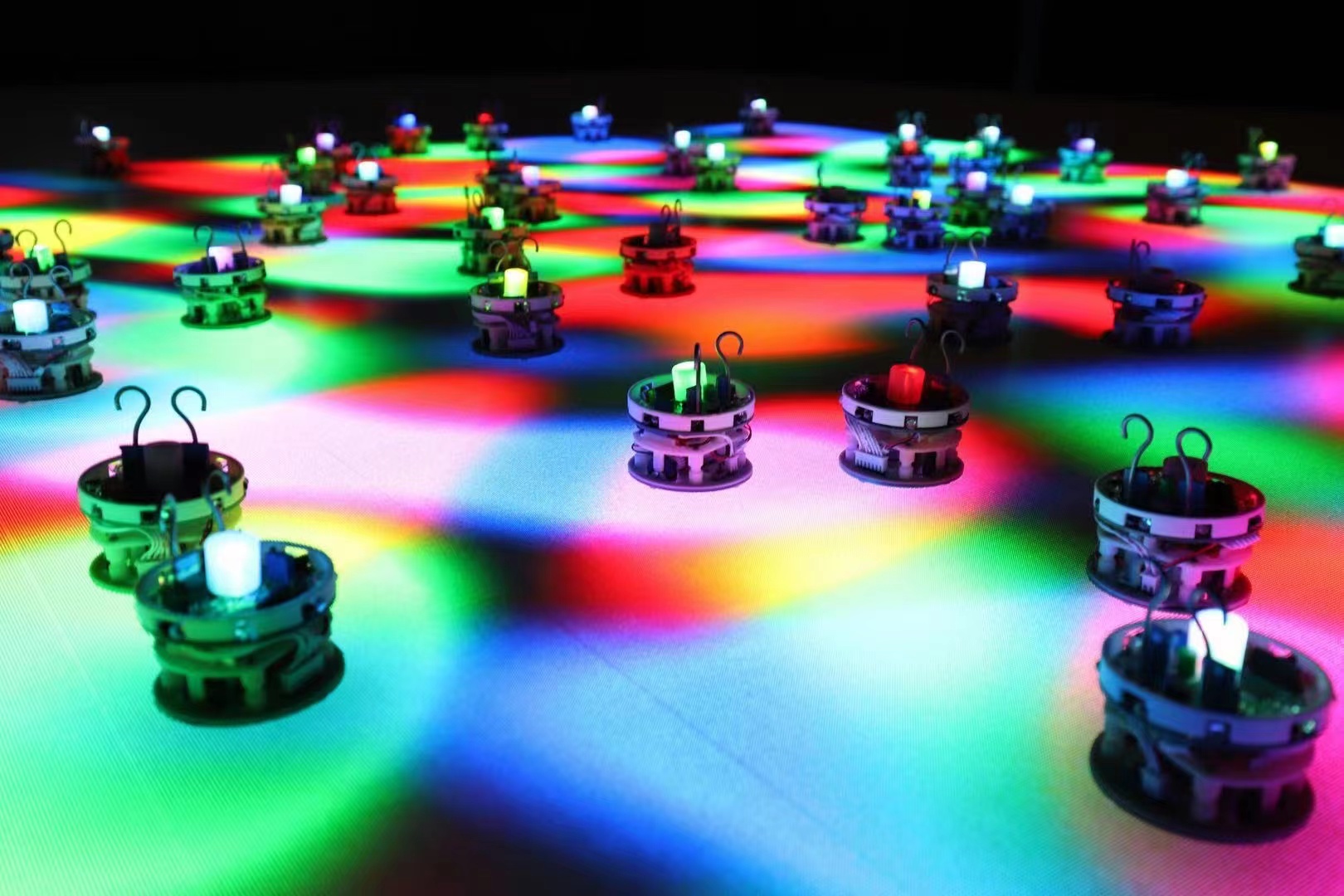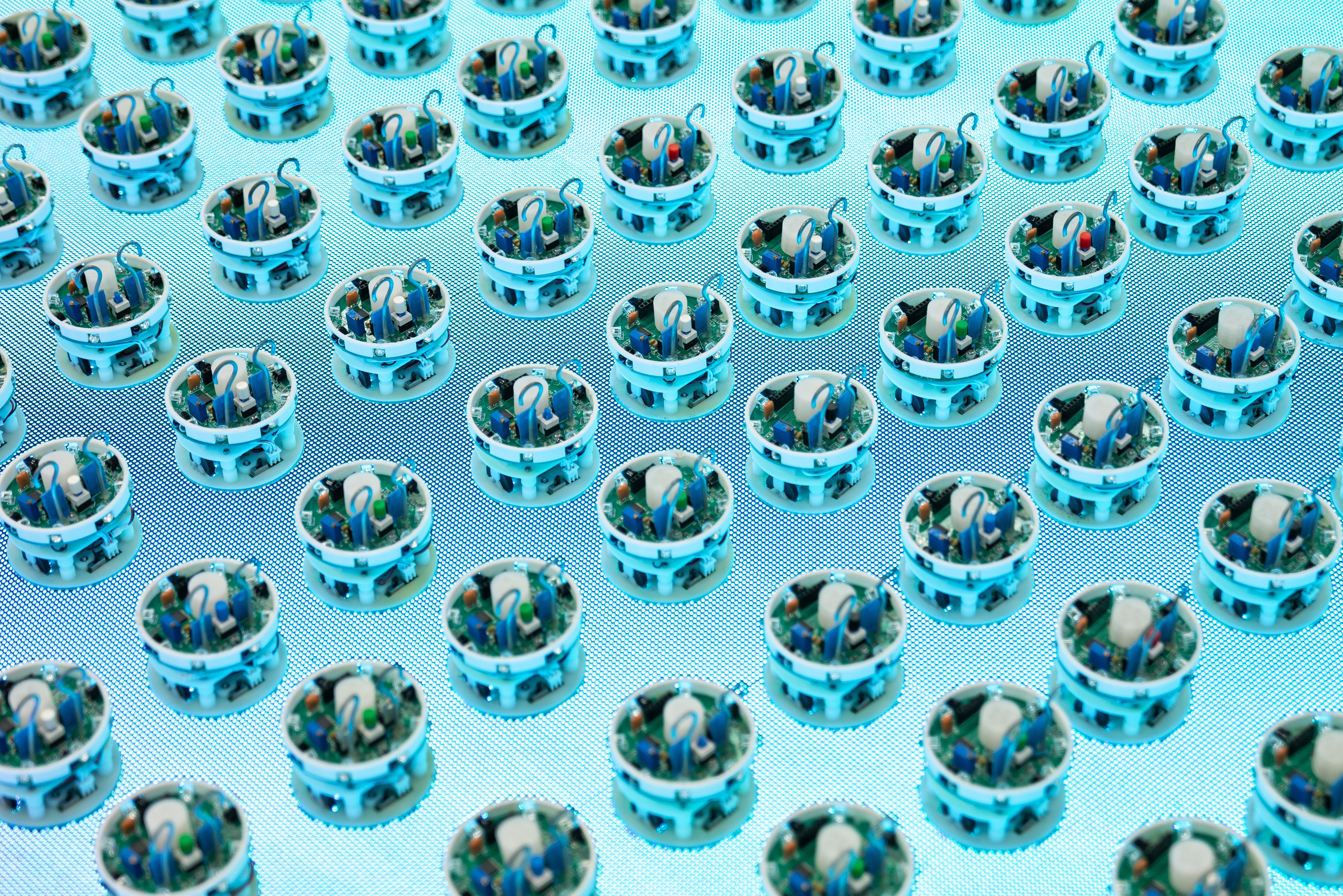 |
Robots as models of evolving systems
Experimental robobiological physics can bring insights into biological evolution. We present a development of hybrid analog/digital autonomous robots with mutable diploid dominant/recessive 6-byte genomes. The robots are capable of death, rebirth, and breeding. We map the quasi-steady-state surviving local density of the robots onto a multidimensional abstract “survival landscape.” We show that robot death in complex, self-adaptive stress landscapes proceeds by a general lowering of the robotic genetic diversity, and that stochastically changing landscapes are the most difficult to survive. |
 |
Emergent Field-Driven Robot Swarm States
We present an ecology-inspired form of active matter consisting of a robot swarm. Each robot moves over a planar dynamic resource environment represented by a large light-emitting diode array in search of maximum light intensity; the robots deplete (dim) locally by their presence the local light intensity and seek maximum light intensity. Their movement is directed along the steepest local light intensity gradient; we call this emergent symmetry breaking motion “field drive.” We show there emerge dynamic and spatial transitions similar to gas, crystalline, liquid, glass, and jammed states as a function of robot density, resource consumption rates, and resource recovery rates. Paradoxically the nongas states emerge from smooth, flat resource landscapes, not rough ones, and each state can directly move to a glassy state if the resource recovery rate is slow enough, at any robot density. |
 |
Development of elastic artificial vessels with a digital pulse flow system to investigate the risk of restenosis and vasospasm.(Co-PI : Guo Chen)
In this study, we constructed a digital pulse flow system based on a group of programmable solenoid valves, to mimic dynamic blood flows in the left coronary artery. Elastic artificial vessels, with internally cultured endothelial cells, were used to simulate vessel function and physiology. Based on this novel platform, we systematically explored cell proliferation and function in artificial vessels implanted with bare metal stents or drug-eluting stents, using unstented vessels as controls, under static and pulse flow conditions. The results indicate that the natural shear stresses of dynamic blood flow actually benefit endothelial cell attachment and proliferation. Our simulation establishes a realistic in vitro model for pathological studies of restenosis and vasospasm, shows potential for evaluation of new stent designs, and could help develop individualised therapies for patients with atherosclerosis. |
 |
Decipher the mystery of microenvironment-enhanced cancer invasion via engineered heterogeneous ECM.(Co-PI : Qihui Fan)
Tumor metastatic progression is not solely promoted by genetic mutation and protein expression, but also related to locally re-constructed heterogeneous tissue environment. Currently, we construct engineered collagen I-Matrigel composite extracellular matrix (ECM) with adjustable heterogeneity in an in vitro biochip model designed to simulate the in vivo heterogeneous tumor microenvironment. The composite ECM was used to determine the influence of the local collagen fiber orientation order on collective migration persistence and invasion ability of tumor. We found that the local fiber alignment enhanced cell-ECM interactions. Specifically, invasive MDA-MB-231 metastatic breast cancer cells followed the local fiber alignment direction and gained aggressive invasion potential in crossing a 100% Matrigel region. This process is similar to the breakthrough of the basement membrane by invasive tumor cells in in vivo, which is a crucial step in cancer metastasis. It implies that tumor biophysical microenvironment recovery and local tissue treatment therapy for patients could be a consideration for improved survival rates. |
 |
Accurate 3D reconstruction of cardiovascular system and non invasive diagnosis by fluid mechanics. (Co-PI :Guo Chen)
It is known that, in bacteria, genes are expressed as a response to metabolic or any external stress in order to increase their chance of survival. One such gene in E.coli is the rpoS gene; it regulates the expression of a wide variety of stress- related genes which triggers entrance into stationary phase. We use a genetically engineered rpoS mutant to study the interaction of two competing species of bacteria.
|
 |
3D Bio-printing.(Co-PI :Ruchuan Liu)
To further investigate the complex biological and medical problems, an in virtual expermental tool is urgently needed to simulate the three-dimensional complex micro environment of arganisms(such as the human body). we will develop the first 3-D Micro-ecology simulation system (3-D MESS) based on 3-D bio-printing technique.Here, a home built ultraviolet digital precise projection technique is the core, the accuracy of printing is ~2-3 micron, and the 3-D hydrogel structure is controlled by UV light. By incorporating the living cells injection and the light sheet imaging, we would like to establish a comprehensive micro ecology simulation platform, which is based on a set of high resolution biological 3-D printer and is highly integrated with materials preparation, structure reconstruvtion, image processing and experimental operation. |
 |
Our aim is to study, from a physics point of view, the behavior of metastatic cancer cells in contact with normal tissues. We've recently started to study the behovior of prostate cancer cells inside microenvironments. Our aim is to be able to determine the phenotypic changes in a metastatic cancer cell that allows it to attack normal tissues. |
|

|
Reconstructing cancer cell metastasis model in in-vitro.Cancer metastasis is a major reason why cancer kills: about 90% of cancer patients die of metastasis. But we know very little about this fatal process, one important reason is in real tumor tissue, invasion and metastasis occurred in too complex extracellular matrix (ECM) environment to be elucidated. By well controled chemical gradients and ECM properties, we can construct invasion microenviroment in vitro to observe and study the invasion process in real time. Picture on right is a “finger” formed when high invasive breast cancer cells (MDA-MB-231) invade in the Matrigel after weeks, this “finger” form was also indicated by computer simulation. The models are expected not only to help understand the complete process and principles of the metastasis, but also help to testify the cell metastatic potentials from clinic samples as well as help classify their molecular mechanism. |
|

|
Cell collective behavior during invasion.Tumor invasion and metastasis is not a single alone phenomenon. As a group, they may play games with each other and their strategy vary according to the environment changing. To study cell collective migration behavior during cancer invasion process, a “cell running track” microchip consists of parallel lanes with different width spaced by protein repellent coating (PRC, a gel can prohibit cell adherence on its surface) surface was fabricated. By long time track of individual cells movement in these different confined space, we are expecting to find competence/collaboration models of Cell.
|
